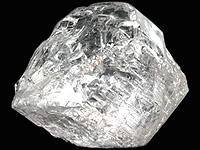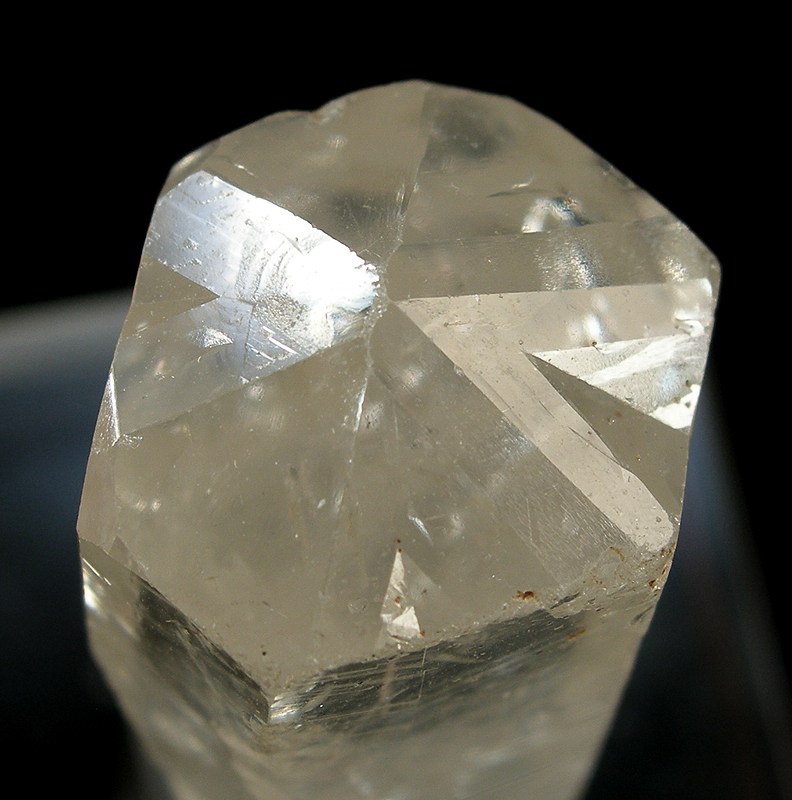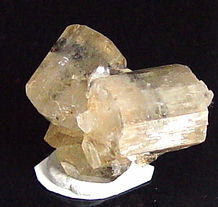Phenakite
Phenakit is a rarely occurring mineral from the mineral class of " silicate and germanate ". It crystallizes in the trigonal crystal system with the chemical composition Be2 [ SiO4 ] and developed mostly tabular to long prismatic crystals, but also radial- or -grained mineral aggregates.
Reiner Phenakit is colorless. However, it may be caused by foreign admixtures of white, yellow, pink or red brown color.
Etymology and history
The mineral was named because of its similarity and thus likelihood of confusion quartz from the ancient Greek word φέναξ [ p ʰ enax ] for " Deceiver ", which possibly φαίνω [ p ʰ ai̯nɔ ː ] ' ( he ) seem to make known " (probably from * φάνjω * [ p ʰ áni̯ɔ ː ]; . . cf. ai vibhava; related to φημί [ p ʰ ɛ ː mí ] "say" - from Mycenaean
Was first found Phenakit 1833 in the emerald mine at Malysheva in Russia and Nils Gustaf Nordenskiöld described by ( 1792-1866 ), a Finnish mineralogist and traveler.
Classification
In the old ( 8th edition ) and new classification of minerals according to Strunz ( 9th edition ) of the Phenakit belongs to the department of the " island silicates ( nesosilicates ) ". The new Strunz'sche Mineral classification divides this department but now more precisely by the presence or absence of other anions and the coordination of the cations in the crystal structure. The mineral is found in accordance with the division of the " island silicates without other anions and cations in tetrahedraler coordination ", where it forms a separate group together with eukryptite, willemite and the confirmed yet by the IMA as an independent mineral Xingsaoit.
The commonly used in English-speaking classification of minerals according to Dana sorted the Phenakit also in the department of " island silicates and SiO4 groups with cations in coordination " where it forms as Leitmineral together with willemite and eukryptite the Phenakitgruppe.
Education and Locations
Phenakit either forms in igneous rocks such as granitic pegmatites or metamorphic rocks such as mica schist, but also by hydrothermal processes in the aged. He therefore found at its paragenesis among others, apatite, beryl, chrysoberyl, fluorite, muscovite, quartz and topaz.
Worldwide Phenakit has been deployed at over 260 localities (as of 2009) detected. Rich in Phenakitfunden ( with three or more regions) are particularly Brazil, Germany, France, Italy, Canada, Norway, Austria, Sweden, Switzerland and the United States ..
Known by finds particularly large or well-developed crystals was mainly Kragerø in Telemark ( Norway) with crystal finds up to 25 cm in length and São Miguel de Piracicaba in Minas Gerais (Brazil ), where up to 10 cm long crystals were revealed. In Sri Lanka also Phenakite were with cat's eye effect found.
Crystal structure
Phenakit trigonal crystallized in the space group with the lattice parameters a = 12.47 Å and c = 8.25 Å and 18 formula units per unit cell.
Use as a gemstone
Phenakit is only used as a gemstone. Despite his good physical (high hardness) and optical properties - be clear, lively vitreous luster can be sanded and polished to increase greasy - it is rarely found in stores. Likelihood of confusion especially with the colorless variety of quartz, rock crystal, but also with beryl, Beryllonite, Cerussite, Danburite and topaz. Depending on the location -dependent compositions may fade when exposed to light over time colored stones, however.










